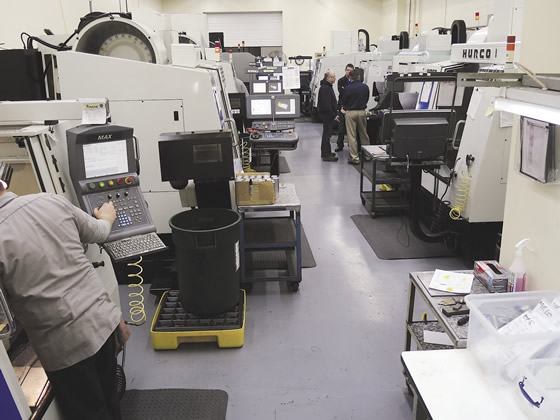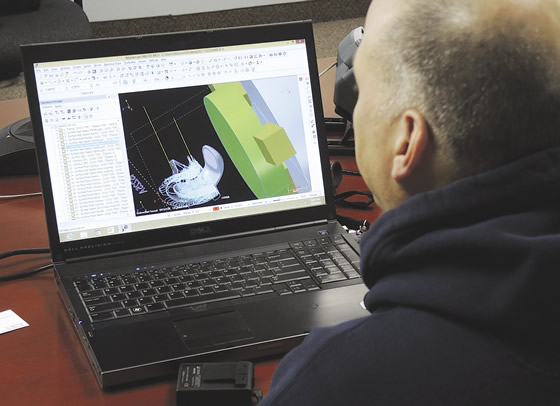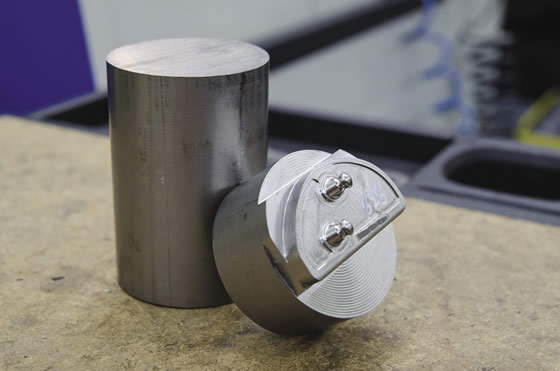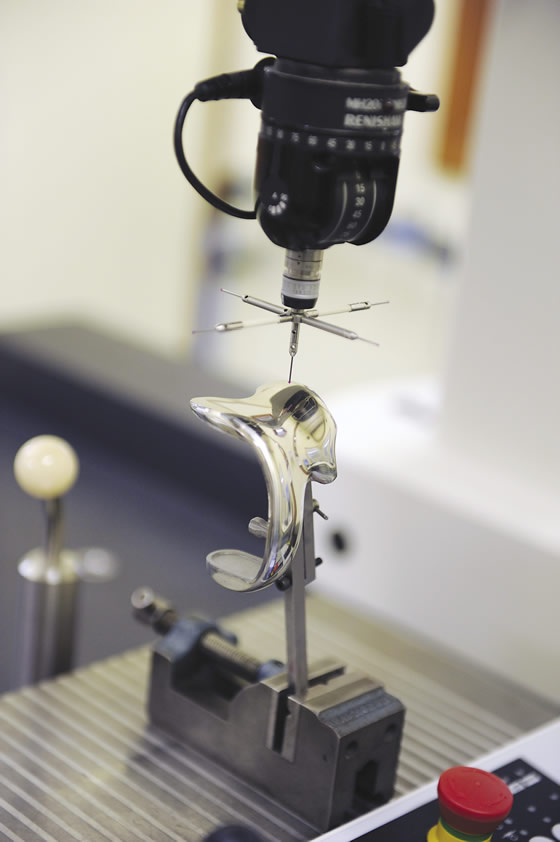When Dan Doiron took the job of lead CNC programmer at Micron Products Inc., it didn’t take him long to conclude that the company’s sophisticated template-based manufacturing processes could be improved with a more flexible CAM system. However, being a newcomer, he was reluctant to argue against what was already working. Instead, he bided his time.

In the past 5 years, the amount of advanced CNC equipment in Micron Product’s orthopedic machining work cell has doubled while the number of programmer/machinists has remained about the same due to the use of more efficient advanced CAM technology.
His opportunity came a little over a year later when Micron, a Fitchburg, Mass.-based contract manufacturer that specializes in sensors, plastic injection molding and machining medical devices, landed a major new contract. It would require the company to manufacture highly sculptured knee-replacement prostheses made of cobalt chrome, what Doiron calls “the most unforgiving material I’ve ever come across.” Creating CNC programs to make these products with the resident CAM software presented numerous issues, including:
- Devising adequate workholding to hold parts securely without marring surface finish while allowing tools to reach more areas on the part in a single setup.
- Dealing with exceptional levels of tool breakage encountered because of the hardness of materials combined with the long tool reach that is sometimes required makes tools more vulnerable to breakage.
- The ever-present need to maintain quality levels when machining an exceptionally difficult material while still improving cycle times.
With the sales process for the cobalt-chrome knee-replacement prostheses underway, Doiron had prepared a machining strategy for these new parts using Dynamic Machining Technology, a feature in the latest versions of Mastercam CAD/CAM software, developed by CNC Software Inc., Tolland, Conn.
For many months, he had been experimenting with a Mastercam machining strategies using an evaluation copy provided by MACDAC Engineering, Somers, Conn., the local Mastercam reseller. With support from the reseller via GoToMeeting, Doiron was able to present his management with a CAM solution that not only addressed the challenges of machining cobalt chrome, but improved the template-based manufacturing processes used to make all of Micron’s products.
The ReplacementsMicron makes one-of-a-kind knee replacements—femorals, tibial trays and ultrahigh-molecular-weight-polyethylene inserts—for major medical device suppliers. Each part is customized to produce an ideal fit for each patient. For example, the company produces more than 80 tray designs and each has an infinite amount of dimensional and geometric variability based on measurements taken from individual patients.
Lead times on the implants are often as short as 7 days. However, when emergency surgery is required, Micron can achieve even shorter turnarounds. One factor enabling fast turnaround is that all of the designs reside in CAM templates that can be transformed into CNC programs.

Programmer/machinist Dan Doiron uses Mastercam’s backplot simulation on every implant to ascertain that CNC toolpaths will not encounter interference.
“With the previous CAM software, it took about 45 minutes to produce a CNC program from the template,” Doiron said. “Now it takes less than a third of the time using Mastercam.” The CAD model is imported from SolidWorks and regenerates the toolpaths based on the template.
Workpieces for the tibial trays and femorals are usually castings. However, if one is unavailable, Mastercam can set new boundaries so the knee part can be machined from a monolithic workpiece.
Getting a GripOne of the biggest challenges Micron faced with the new contract was finding a way to firmly hold the highly sculptured castings so they could be machined effectively. Too tight a grip could mar the part’s surface, while too little pressure would require machining at lower feeds and speeds to keep the parts from popping out of the fixture.
The solution was twofold. Using Mastercam’s Solids features allowed Micron to produce fixtures that avoided holding on critical surfaces, but also made it possible to create precise mirror-image geometries of part features in the fixture to provide optimal contact areas for holding.

This partially machined knee tibia tray is made of cobalt chrome.
The other part of the solution was using Mastercam’s Dynamic Motion feature to machine even extremely hard cobalt chrome (approximately 47 HRC) at high surface speeds (working up or down from 300 sfm to find the “sweet spot” that results in optimal material removal and tool life).
Dynamic Motion analyzes the part model to create efficient toolpaths that use as much flute length as possible, but with small step-overs. This intelligence also continually adjusts the tool trajectory throughout the operation based on the material conditions ahead of the tool, which guarantees consistent tool/material engagement. The result is high material-removal rates in keeping with the optimal chip load (based on the tool manufacturer’s recommendations) and cutting forces distributed evenly over the full tool length for increased tool life.
“It is particularly advantageous for roughing,” Doiron said. “The traditional way I was taught was to step down progressively, 0.025 " at a time, until you get to the bottom of the pocket. In this stuff, you cannot do that because the cutter will not last more than two passes before it is blown out. It just kills the corners and you are not going to get any tool life at all. So you need the fullest possible engagement of the flute length. Dynamic is always my first option. Without it, we would be making about three parts per tool with it, but we are getting many times more.”
Tightening Machine CyclesBefore acquiring Mastercam, Doiron had already optimized the feeds and speeds in his CAM templates for reasonably high levels of productivity without sacrificing part quality. Now he is reducing cycle times on a per part basis when he identifies an opportunity for improvement.

A patient-specific femoral implant made from cobalt-chrome bar stock undergoing final inspection.
In one instance, he took 40 minutes off a 90-minute cycle simply by experimenting with different feeds, speeds and step-overs within Dynamic Motion toolpaths. This degree of improvement is frequently, but not always, possible. He said vibration is often the limiting factor on how much the cycle time can be improved. In another case, a 150-minute cycle for a trunnion-mounted workpiece was reduced by 60 minutes when the customer added bigger corner radii to the design. The tool was changed from a 4-flute to a 6-flute endmill and Dynamic Motion cutting speeds were increased by about 30 percent, further reducing cycle time.
Doiron emphasized that many elements go into manufacturing processes that allow quality targets to be met when machining critical medical parts on a fast-turnaround basis. During the past 5 years, Micron has successfully adapted its manufacturing processes to meet its customers’ requirements. The results include:
- The number of CNC machines the company operates has grown from three to 14 to keep pace with demand.
- Per machine productivity has increased by about 25 percent.
- Three seats of a basic CAM software have expanded to eight seats of Mastercam.
- Tool life has been extended many times over even when cutting materials like cobalt chrome.
Using the Dynamic Motion feature, Micron has captured a new stream of business that allows the company to grow exponentially, moving quickly from running a single shift to three shifts. CTE
Related Glossary Terms
- computer numerical control ( CNC)
computer numerical control ( CNC)
Microprocessor-based controller dedicated to a machine tool that permits the creation or modification of parts. Programmed numerical control activates the machine’s servos and spindle drives and controls the various machining operations. See DNC, direct numerical control; NC, numerical control.
- computer-aided design ( CAD)
computer-aided design ( CAD)
Product-design functions performed with the help of computers and special software.
- computer-aided manufacturing ( CAM)
computer-aided manufacturing ( CAM)
Use of computers to control machining and manufacturing processes.
- endmill
endmill
Milling cutter held by its shank that cuts on its periphery and, if so configured, on its free end. Takes a variety of shapes (single- and double-end, roughing, ballnose and cup-end) and sizes (stub, medium, long and extra-long). Also comes with differing numbers of flutes.
- fixture
fixture
Device, often made in-house, that holds a specific workpiece. See jig; modular fixturing.
- hardness
hardness
Hardness is a measure of the resistance of a material to surface indentation or abrasion. There is no absolute scale for hardness. In order to express hardness quantitatively, each type of test has its own scale, which defines hardness. Indentation hardness obtained through static methods is measured by Brinell, Rockwell, Vickers and Knoop tests. Hardness without indentation is measured by a dynamic method, known as the Scleroscope test.
- micron
micron
Measure of length that is equal to one-millionth of a meter.






